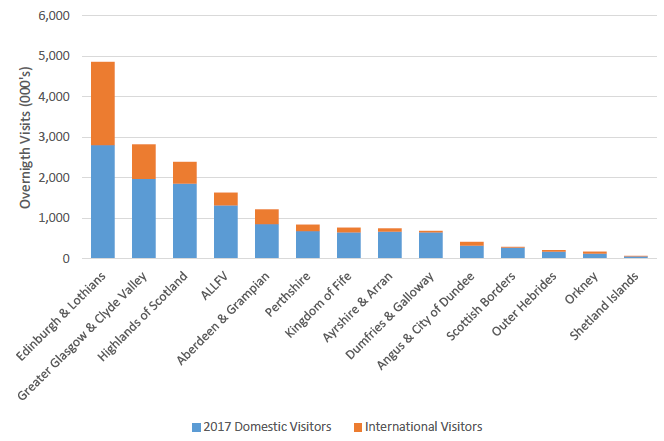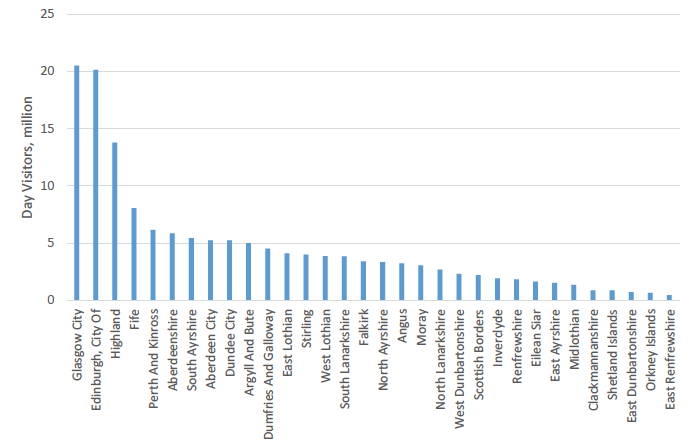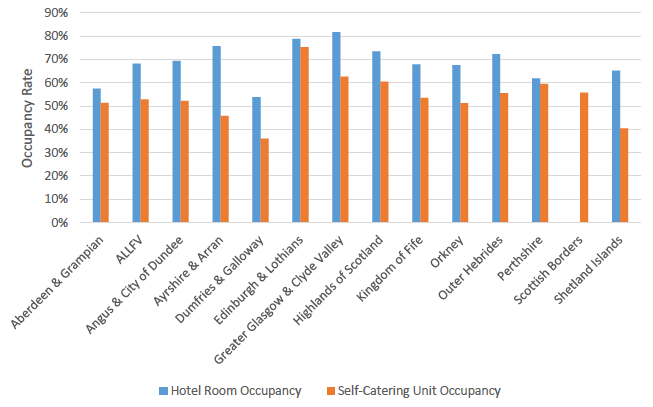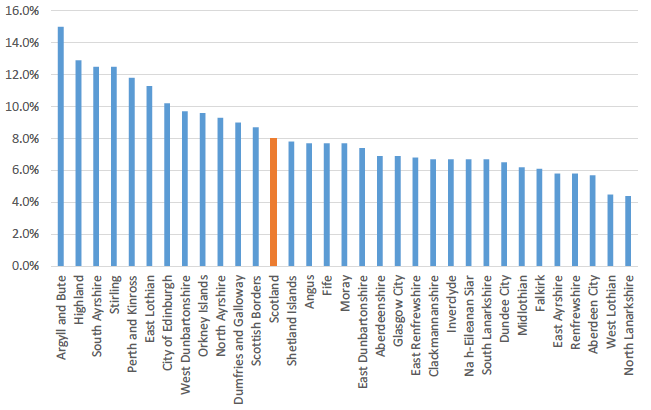Tourism tax: discussion document
This document has been prepared to support our national discussion on transient visitor (tourist) taxes in Scotland. Comments can be sent to tourismdiscussion@gov.scot.
3. Tourism in Scotland
Tourism is a significant part of Scotland’s economy, in terms of its size, economic contribution, and its distribution across Scotland. This section provides overview of tourism activity in Scotland, including trends in visitor numbers, spend and distribution; accommodation; and economic contribution.
Overnight Visitors[3]
In 2017, there were almost 14.9 million overnight visits to Scotland, the majority of which were made by visitors from within Great Britain. Around 5.4 million (36 per cent) visits were made by people from Scotland, 6.3 million (42 per cent) came from elsewhere in Great Britain, and around 3.2 million (22 per cent) came from overseas.
Overall visitor numbers increased by 4.3 per cent between 2016 and 2017, with international visitors increasing by almost 17 per cent. However, since 2011, overall visitor numbers have fallen by over 5 per cent, with growth in visitors from overseas being offset by reductions in visitor numbers from the UK.
Visitor expenditure has increased in recent years. Overnight visitors spent almost £5.3 billion in 2017 – up over 9 per cent in real terms on 2016[4]. Within this, spending by overseas visitors was worth almost £2.3 billion – up almost 21 per cent in real terms on 2016. However, over the longer term, overall expenditure growth has been relatively stable: while expenditure by overseas visitors increased by almost 40 per cent in real terms between 2011 and 2017, overall overnight expenditure by tourists increased by 6.4 per cent in real terms over the same period.
Chart 1 shows the distribution of overnight visits across Scotland in 2017, revealing significant regional concentrations of visitors.
Chart 1: Overnight Visitors by Region of Scotland, 2017

Source: ONS (2018) International Passenger Survey 2015-17; VisitEngland, VisitScotland and Visit Wales (2018) Great Britain Tourism Survey 2015-17; VisitScotland (2017) Islands Visitor Survey 2017.
Edinburgh and the Lothians received almost 5 million overnight visitors in 2017, 29 per cent of total overnight visitors to Scotland, and also received around 44 per cent of Scotland’s overseas overnight visitors. Greater Glasgow and the Highlands received 17 per cent and 11 per cent of Scotland’s overnight visitors respectively.
Visitor expenditure across Scotland is similarly concentrated. Edinburgh received around £1.8 billion of expenditure by overnight visitors in 2017: 35 per cent of the Scottish total. Within this, Edinburgh accounted for over £1 billion of overseas visitor expenditure: 45 per cent of Scotland’s total. Glasgow accounted for over £700 million of overnight visitor expenditure in 2017, around 13 per cent of Scotland’s total.
Day Visitors[5]
Day visitors also represent a significant source of tourism activity across Scotland. In 2017, there were over 151 million day visits within Scotland, accounting for around £6 billion of tourist expenditure. The vast majority of day visits (84 per cent) were by visitors from within Scotland.
Numbers of visits increased by 6.4 per cent between 2016 and 2017, but have fallen by 2.1 per cent since 2011. Expenditure by day visitors, while rising by almost 20 per cent in real terms between 2016 and 2017, has also declined significantly since 2011, falling by 23 per cent in real terms between 2011 and 2017.
Chart 2 shows the distribution of day visitors across Scotland in 2017.
Chart 2: Day Visitors Across Scotland, 2017

Source: ONS (2017) Great Britain Day Visitor Survey
Glasgow and Edinburgh each received over 20 million visitors, or around 14 per cent of total day visitors each within Scotland. Glasgow also received over £1.1 billion (22 per cent) of day visitor expenditure, while Edinburgh received almost £960 million (18 per cent).
Scotland has a diverse range of visitor attractions. Data from the Moffat Centre also suggests that in 2017, visitor attractions in Scotland experienced a 7.0 per cent increase in visitor numbers between 2016 and 2017. Attractions in Greater Glasgow and the Clyde Valley and Edinburgh and the Lothians received the greatest number of visitors (almost 21 million and over 17 million respectively); while the National Museum of Scotland and Edinburgh Castle both exceeded 2 million visitors in 2017, making them the most visited attractions outside of London[6].
Table 1 sets out the most visited paid and free attractions in Scotland in 2017. A number of these receive financial support from government in Scotland, either from the Scottish Government, or from Local Authorities.
Table 1: Most Visited Attractions in Scotland, 2017
| Rank |
Paid Attractions |
Free Attractions |
||
|---|---|---|---|---|
| Attraction |
Visitor Numbers |
Attraction |
Visitor Numbers |
|
| 1 |
Edinburgh Castle |
2,063,709 |
National Museum of Scotland |
2,165,601 |
| 2 |
Edinburgh Bus Tours |
690,082 |
Scottish National Gallery |
1,600,761 |
| 3 |
Stirling Castle |
567,259 |
Riverside Museum |
1,355,359 |
| 4 |
Edinburgh Zoo |
519,281 |
Kelvingrove Art Gallery & Museum |
1,304,072 |
| 5 |
Urquhart Castle |
488,136 |
St Giles' Cathedral |
1,285,654 |
| 6 |
Glasgow Science Centre |
425,961 |
Royal Botanic Garden Edinburgh |
821,955 |
| 7 |
Glenfinnan Monument |
396,448 |
Gretna Green Famous Blacksmith's Shop |
812,177 |
| 8 |
Royal Yacht Britannia |
390,482 |
National War Museum |
764,079 |
| 9 |
The Scotch Whisky Experience |
376,757 |
Regimental Museum of the Royal Scots Dragoon Guards |
745,208 |
| 10 |
Loch Ness by Jacobite |
298,000 |
Gallery of Modern Art |
670,555 |
Source: Moffat Centre Glasgow Caledonian University (2018), Scottish Visitor Attraction Monitor 2017
Accommodation in Scotland
There are a range of economic activities contained within the Sustainable Tourism Growth Sector, with provision of accommodation comprising a significant portion of the sector. Activities included within accommodation are:
- Hotels and similar accommodation;
- Holiday and other short-stay accommodation; and,
- Camping grounds, recreational vehicle parks and trailer parks
In 2018, there were over 3,000 registered business sites within the accommodation sector across Scotland. Table 2 sets out the distribution of these by size of business and accommodation type.
Table 2: Accommodation, Registered Business Sites, by Employee Sizeband, 2018[7]
| 0-4 Employees |
5-9 Employees |
10-14 Employees |
15-49 Employees |
50+ Employees |
Total |
|
|---|---|---|---|---|---|---|
| Hotels and similar accommodation |
480 |
320 |
240 |
710 |
225 |
1,980 |
| Holiday and other short-stay accommodation |
635 |
125 |
35 |
35 |
5 |
840 |
| Camping grounds, recreational vehicle parks and trailer parks |
200 |
50 |
20 |
20 |
10 |
300 |
| Total |
1,320 |
495 |
295 |
765 |
240 |
3,120 |
Source: ONS (2018), Inter-Departmental Business Register.
Hotel accommodation forms the majority of registered accommodation enterprises, with the majority of these being small businesses.
Activity within the accommodation sector varies across Scotland, and across the year. In 2017, the average hotel room occupancy rate was over 72 per cent: however, this rate varied from a low of around 51 per cent in January 2017 to a high of 89 per cent in August[8]. Self-catering unit occupancy rates averaged at around 54 per cent in 2017, and varied between a low of 29 per cent in January to 85 per cent in August.
Occupancy rates also vary across Scotland’s regions. Chart 3 sets out average occupancy rates for hotel rooms and self-catering units across Scotland.
Chart 3: Hotel Room and Self-Catering Occupancy Rates, 2017

Source: VisitScotland (2017), Scottish Accommodation Occupancy Survey.
This shows both Edinburgh and the Lothians and Greater Glasgow and Clyde Valley achieving relatively high levels of occupancy across the year; however, occupancy rates were relatively low in both Aberdeen & Grampian and Dumfries and Galloway.
Economic Contribution
The tourism sector makes an important economic contribution to Scotland, both at a national level, and across Scotland.
The Sustainable Tourism Growth sector employed 206,000 across Scotland in 2017[9]. This represented around 8 per cent of employment in Scotland as a whole. Within this, the accommodation sector employed 56,000: around 27 per cent of the total.
Tourism is a significant employer across Scotland. Around 31 per cent of the sector’s employment is accounted for by Edinburgh and Glasgow, with 34,000 and 29,000 employees respectively. The sector is also a particularly important source of employment in areas like Argyll and Bute, Highlands, and Stirling, where it accounts for around 15 per cent, 13 per cent, and 12.5 per cent of employment respectively.
Chart 4 sets out the relative importance of tourism as an employer across Scotland’s Local Authority areas.
Chart 4: Sustainable Tourism Employment as Share of Local Authority Employment, 2017

Source: ONS (2018), Business Register and Employment Survey
In addition to its contribution to employment, the sustainable tourism sector also supports activity in other sectors of the Scottish Economy.
In 2017, total expenditure by domestic and non-domestic tourists in Scotland, including overnight and day visitors, was around £11 billion[10]. Analysis using the Scottish Government’s Input-Output tables[11] indicates that, after adjusting for the imports purchased by the sector, and including an estimate of capital expenditure undertaken by the sector, this directly supported £5.2 billion of GDP (in basic prices) in the Scottish Economy, including around £3.6 billion in the hotels, distribution and catering sector.
However, this also supported activity in the wider Scottish Economy through the purchases made by the sector from the wider Scottish supply chain, and through the wages spent by those working in the sector. Purchases from the supply chain accounted for around £1.2 billion of GDP in the wider Scottish Economy, including around £422 million of GDP in Finance and Business Services. Wages spent by those working in the sector and the supply chain also supported around a further £1.4 billion of GDP.
Taken together, spending by tourists in Scotland generated around £14 billion of economic activity in the wider Scottish supply chain and contributed around £8 billion to Scottish GDP (in basic prices). This represents about 6 per cent of total Scottish GDP.
Contact
Email: Kevin Brady
There is a problem
Thanks for your feedback